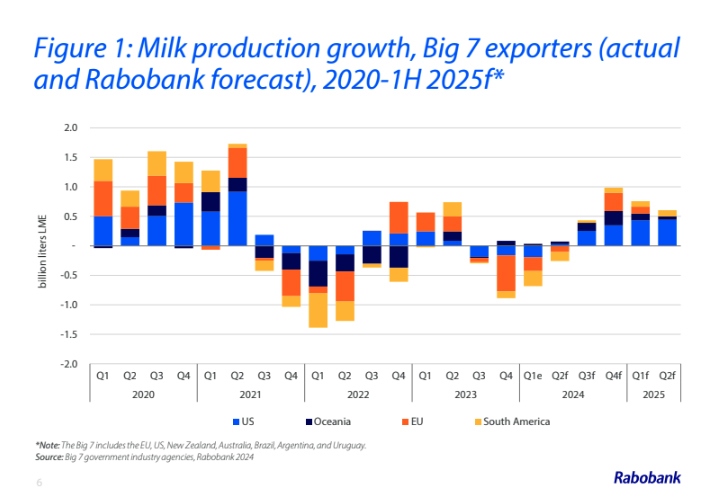By Emma Higgins, senior agricultural analyst at Rabobank
Improved dairy commodity prices are on the horizon for most key dairy producing regions around the world throughout 2024, as dairy commodity prices recover from the lows noted towards the end of 2023.
Skim milk powder prices in the European Union, the United States and Oceania are expected to see a slow but steady recovery throughout this year, driven by subtle demand improvements and, in the US, a reduction in supply coupled with stocks sinking to an eight-year low.
A similar trend in whole milk powder is expected, with the slow but steady gains that materialised at the end of 2023 persisting in the coming quarters.
Improved global dairy commodity prices will likely be supported by weak global milk supply.
We anticipate that milk production in key exporting areas will continue to struggle in the first half of this year, and we’re expecting lower output in the first and second quarter following the weakness in the second half of last year, meaning milk production will be lower for an entire year.
Rabobank expects most regions will contribute to the weakness, with US production likely to be lower in the first quarter, while EU and New Zealand output is forecast to be down throughout the first half.
NZ milk production has held up much stronger than earlier anticipated. On a tonnage basis, a “non-traditional El Niño” has seen milk supply running just 0.5% lower compared to last season for the eight months to January 2024.
Yet milk solids collections are higher than the previous year by 0.8% over the same period, driven by a solid South Island performance.

We anticipate milk production to decrease by 0.7% on a tonnage basis for the full 2023/24 year. The new 2024/25 season is expected to get off to a better start, simply on the assumption of poor comparables and improved weather.
Typically, after weak supply growth for an extended period of time, a firmly bullish price response would have materialised, similar to the output pullback in 2021 followed by, in some measures, record high prices into 2022.
However, the supply and demand dynamics are different this time around. Less milk has been shrugged off by global buyers sitting on adequate inventories and macroeconomic worries persist.
The good news is that looking ahead, there is increasing evidence that dairy demand is on the upswing. The worst of the recessionary fears have passed in some countries, and while global economic growth will likely be subdued, the overall outlook is modestly subdued.
We’ve also seen positive developments in China with retail and food service sales showing strength through the Lunar New Year. Slowing milk production growth in China means we expect imports to improve in 2024, even if they remain lower than the long-term average.
Our expectation is that slow but steady dairy commodity price gains will materialise this year. And accordingly, we’ve now made a small upwards revision to our NZ milk price forecast for the 2023/24 season, increasing this by five cents to $7.80kg/MS.
There are always a number of events that can shift the dial when it comes to dairy commodity markets and, therefore, farm gate prices here in NZ.
One of the key watch factors for the global dairy sector in 2024 is the upcoming elections taking place in many key dairy regions.
European parliament elections are approaching in June while the US will go to the polls to elect a new president and many members of congress in November. Any leadership shifts could mean new approaches to policy, including free trade agreements, sustainability policies, or nutrition priorities that trickle back to impact dairy prices.
Sector participants will also be keeping a close eye on developments in the Dutch and Irish dairy sectors, where farmers are facing lower nitrogen derogation limits that will decrease application rates of organic nitrogen from animal manure in the 2024 season and beyond.
This will reduce carrying capacity per hectare, which could result in farmers re-balancing their herd size and/or higher costs for manure disposal.
And it’s not just the Netherlands and Ireland dealing with this challenge, with Denmark’s derogation allowance also up for renewal in July 2024.
This article first appeared in our sister publication, Dairy Farmer.










